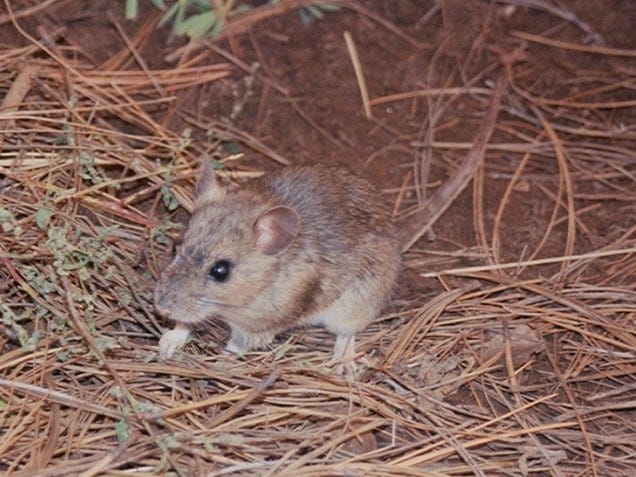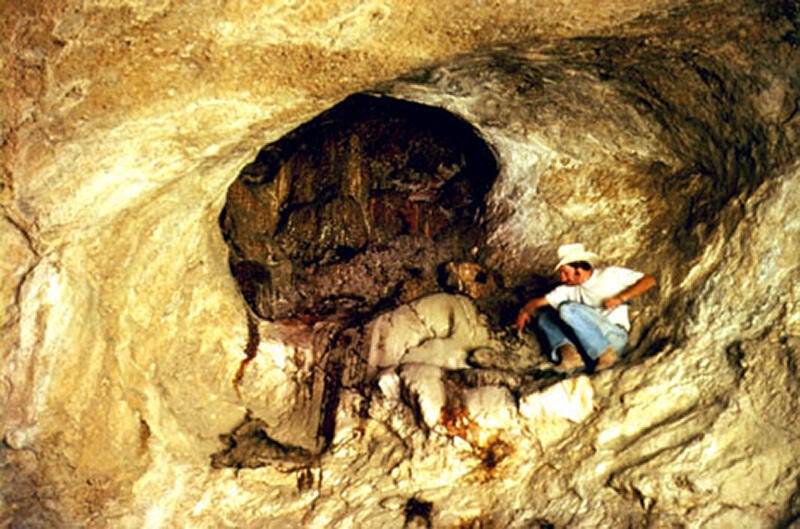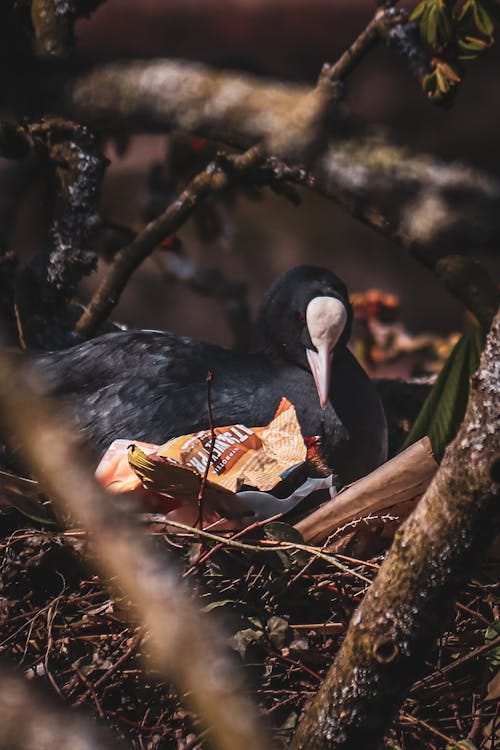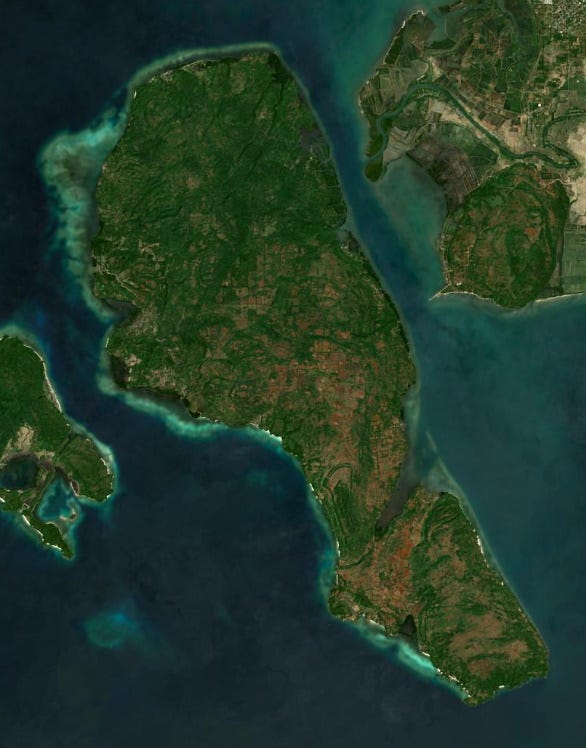
If history is the study of what gets left behind, then here are different ways to mark the passage of time. Old toys. Dusty journals. Sundials. When inspecting the dim vestiges of a human past, the study of rusted blades, bits and pieces of broken pots, the petroglyphs carved on a cliff wall. But for timescales just beyond mortal imagination - somewhere in between the first ocean-going boats and dinosaurs – one may turn to the changes in preserved packrat middens.
Packrats are long-tailed rodents of the genus Neotoma, found throughout North to South America. Some live in boreal forests, others in the desert. Differences in habitat aside, almost all packrat species share two important characteristics. First, they’re herbivorous, relying on the nutrition and water found in fleshy leaves. Second, they build houses.
The secret to a packrat’s survival is prime real estate. Any suitably snug cave or rock crevice will do, where they assemble rough dens made of sticks and the odd animal bone. The overlying stone combined with the dense walls of fibrous material create good insulation; the narrow entrance protects against predators. So sheltered, a rat can eat and sleep and relieve itself in relative safety, while also possessing a dry storeroom for winter. Most of all, there will be blessed peace and quiet. These are solitary animals.
Picture this: a prehistoric packrat foraging in cool Utah woodland. He, true to the name of his kind, is an avid collector of precious objects, mostly stores for his vegetarian pantry, but occasionally also bright rocks, twigs, the odd bleached vertebrae, and other strange trinkets. Right now he’s plucking some fir needles to be enjoyed in the privacy of his home. Ah, domestic life.
Safe from the hungry eyes of Mr. Hawk, the rat chews messily away, bits of fir spilling from his mouth down his feet. He embarks on several more trips throughout the afternoon, foraging in the shadows of a Pleistocene forest, until there’s a layer of plant matter dusting the floor of his den. Just before bed he goes he pees, soaking the ground in urine. The dried urine helps cement successive layers of daily refuse together into a single solid heap – a midden.
Our hero lives, ages, dies. The midden remains, cool and dry in its secluded hidey-hole. Over time the faintly disgusting pile hardens into a quasi-rock that survives the ages.
Twenty-five thousand years later, somewhere in the sunny expanse of what is now Utah, the United States, in Salt Creek, Canyonlands National Park, a paleobiologist excavates the midden contents of an ancient crevice. The work is detailed and meticulous. Through microscopes they count the number of resin canals running through centimeter-long preserved conifer needles. Picking apart the hardened debris, they find fragments of Douglas fir, blue spruce, and limber pine, all temperate-weather species.
The scientists don’t stop with just one sample. By studying the contents of many different packrat middens - by comparing those dated twenty-five thousand years ago to those from ten thousand years ago and so on up to the present, and contrasting those found up hillsides to those in lowland plains – scientists can trace the deep environmental past, following the slow migrations of plants as they move to the rhythms of a changing climate. The reward for their hard work is a story.
Once upon a time, during the last ice Age, the hills and plateaus of Salt Creek were peppered with boreal conifers. Then, as the earth went about its epochal cycles of warming and glaciation, the skies warmed, the clouds evaporated away, and hot arid soils replaced the temperate landscape. The firs and their allies retreated to cool bulwarks atop mountain slopes. In their place arrived tides of hardy pinyon, having travelled in slow waves from the baking south, as well as marching columns of junipers, blackbrush, and sagebrush.
This entire process, of course, was accidentally documented by a bunch of herbivorous den-building rodents. It's a tale as old as trash. Bless the humble packrat, whose hoarding habits have given us a treasure trove of ancient wisdom.

People leave traces too. Near the coast of Ilin Island, south of Mindoro, in the Philippines, are several rock shelters littered with mollusk remains.
Millenia ago, groups of shellfish gatherers pried open their game in the shade of yawning limestone overhangs. Over many generations and in the same locations, they ate the soft meat and discarded the shells, forming middens over a meter deep and spanning around ten thousand years of human habitation.
The older, deeper layers contain cracked mud crab pincers and the empty husks of mangrove gastropods. The newer strata are dominated by conches, sea snails, and giant saltwater clams.
The hypothesis goes that thousands of years ago, Ilin Island was connected to Mindoro in one big landmass. But as the ice ages ended and polar icebergs melted away, spilling their mass into the sea, the rising oceans soon split Ilin from the mainland. Coastal estuaries and mangrove forests were gently inundated; rocky shorelines turned to shallow lagoons. Higher and higher crept the incoming waves, until what were mudflats became sprawling reefs.
With their habitual mangrove foraging grounds disappearing, the foragers of Ilin Island responded by venturing deeper into the sea. Instead of snapping up mud crabs, they dove for giant clams. Or at least, that’s what modern archaeologists suspect based on the composition of their dumpsites.
Elsewhere in the Philippines, excavations have unearthed stone spear tips as well as the jaw fragments of three extinct cloud rat species. The dentaries are blackened and burned because of time spent roasting in a fire. Mammalogists know these cloud rats differ from any other of their kind alive today because of the shape of their teeth. It’s surprising how much information you can extract from the curves of a molar.
The three species seem to have disappeared around four thousand years ago. Coincidentally, this is also around the same time the first pottery fragments and the first domesticated pigs appear in Luzon’s archaeological record.
Here is another way to mark the passage of time: the amount of plastic in bird nests. The common coot is an all-black waterbird with a shining ivory beak. It eats almost anything: spiders, worms, algae and assorted weeds. Both males and females take turn feeding the young and taking care of the nest. Because nests are usually built out of natural plant material, which decays quickly in wetland habitats, coots spend a considerable amount of their time rebuilding their nests during successive breeding seasons, year after year.
No longer. The coots living in the bright waterways of Amsterdam, just like their larger hominid neighbors, have been transformed by the widespread adoption of single-use packaging. They – along with their distant relatives, the great crested grebes – are some of the only birds that can survive in the city center. At least part of their success has been attributed to a remarkable ability to incorporate polyethylene into their nests, like young couples building their homes from recycled plastic bricks. It’s worth emphasizing that this is completely novel behavior; a grandfatherly coot transported from the mid-19th century would be just as shocked witnessing this phenomeno, as a medieval retainer would be observing modern children fluently handling fancy new iPhones.
The use of soiled condoms, M&M wrappers, and especially discarded McDonalds ketchup packets, because McDonalds paraphernalia apparently constitute the majority of manmade material that researchers have found in Amsterdam nests, lets common coots sidestep the lack of plant material to construct their homes, there not being plenty of vegetation in the city center. Also, and perhaps for the first time in their history, coots don’t have to keep rebuilding their nests every year anymore. After all, plastics don’t degrade.
So far, the oldest continuously reused coot nest in Amsterdam has been in service for around 30 years. We can infer this because there’s a candy wrapper in that nest bearing a printed ad for the 1994 FIFA World Cup in the United States.
Many, many centuries from now, an archaeologist plumbing the depths of our towns will encounter a distinct stratum of soil riddled with polyvinyl chloride. They will sieve the bright brown and blue scraps from the rest of the wreckage and cry out, here! Here is the signal. This is where it begins. Everything we dig up from here on out belongs to a bygone age of degradation.

Summer arrives heralded by the narra tree in bloom. That and the heat. The sun glares down on Metro Manila; the noon sky is agony on the skin; everywhere in the boiling city yellow petals drop to the pavement in a shower of light. By late May the flood of gold starts draining to empty. Before long the trees are just green again. Season after season on the turning planet, our orbits rolling by almost too quietly for us to notice.
If you’re interested in reading more about middens, fossil shells and cloud rats, and plastics in bird nests, I’ve listed my references below. Please do take a look. I’m always happy to see more people fall into the same rabbit hole I’ve managed to get stuck in.
Once again, thanks for reading!
REFERENCES
Becklin, K. M., Betancourt, J. L., Braasch, J., Dézerald, O., Díaz, F. P., González, A. L., Harbert, R., Holmgren, C. A., Hornsby, A. D., Latorre, C., Matocq, M. D., & Smith, F. A. (2024). New uses for ancient middens: Bridging ecological and evolutionary perspectives. Trends in Ecology & Evolution, 39(5), 479–493. https://doi.org/10.1016/j.tree.2023.12.003
Betancourt, J. L., Devender, T. R. V., & Martin, P. S. (1990). Packrat Middens: The Last 40,000 Years of Biotic Change. University of Arizona Press.
Braasch, J., Betancourt, J., Dézerald, O., Peiris, U., Tapia-Rozas, M., Villagra, C., Latorre, C., & González, A. L. (2025). Establishing Historical Baselines of Arthropod Assemblages Using Rodent Paleomiddens. Global Ecology and Biogeography, 34(2), e70006. https://doi.org/10.1111/geb.70006
Coats, L. L., Cole, K. L., & Mead, J. I. (2008). 50,000 years of vegetation and climate history on the Colorado Plateau, Utah and Arizona, USA. Quaternary Research, 70(2), 322–338. https://doi.org/10.1016/j.yqres.2008.04.006
Cole, K. L. (1990). Reconstruction of past desert vegetation along the Colorado River using packrat middens. Palaeogeography, Palaeoclimatology, Palaeoecology, 76(3–4), 349–366. https://doi.org/10.1016/0031-0182(90)90120-V
Hiemstra, A.-F., Gravendeel, B., & Schilthuizen, M. (2025). Birds documenting the Anthropocene: Stratigraphy of plastic in urban bird nests. Ecology, 106(2), e70010. https://doi.org/10.1002/ecy.70010
Ochoa, J., Mijares, A. S. B., Piper, P. J., Reyes, M. C., & Heaney, L. R. (2021). Three new extinct species from the endemic Philippine cloud rat radiation (Rodentia, Muridae, Phloeomyini). Journal of Mammalogy, 102(3), 909–930. https://doi.org/10.1093/jmammal/gyab023
Pawlik, A. F., Piper, P. J., Faylona, M. G. P. G., Padilla, S. G., Carlos, J., Mijares, A. S. B., Vallejo, B., Reyes, M., Amano, N., Ingicco, T., & Porr, M. (2014). Adaptation and foraging from the Terminal Pleistocene to the Early Holocene: Excavation at Bubog on Ilin Island, Philippines. Journal of Field Archaeology, 39(3), 230–247. https://doi.org/10.1179/0093469014Z.00000000090





